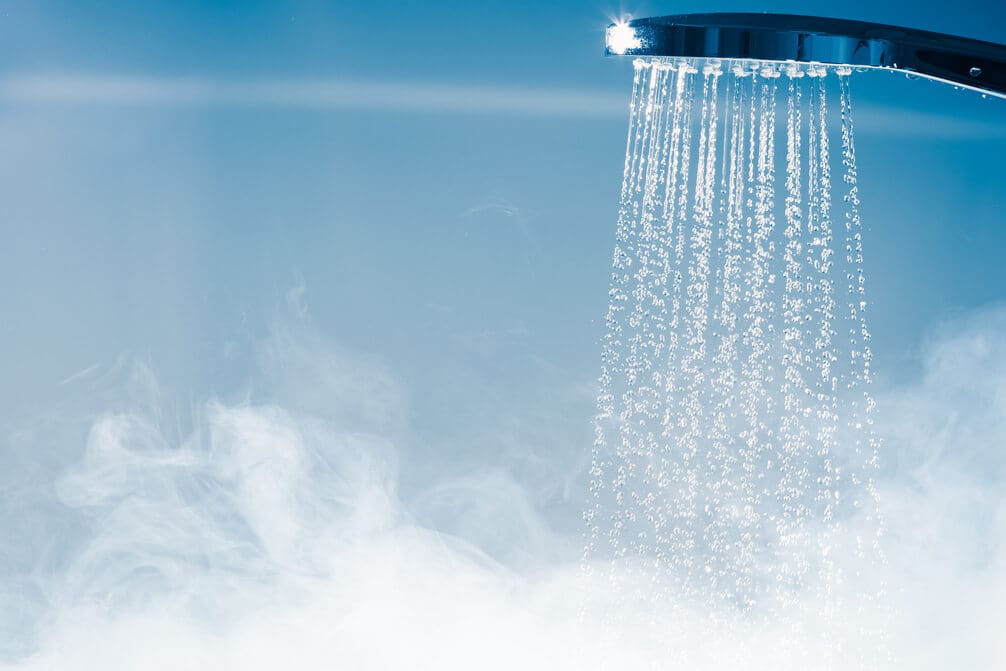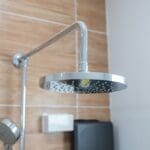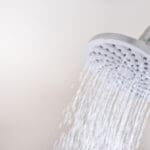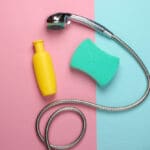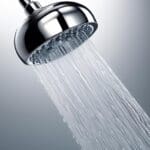Ah, the mysterious case of the shower head that thinks it’s a faucet, endlessly dripping when it’s supposed to be off. You’re about to embark on a noble quest to silence this relentless trickle, armed with nothing but your wits and a wrench.
Let’s not pretend it’s rocket science, but fixing a leaking shower head does require a certain finesse and understanding of plumbing basics.
Key Takeaways
- Determine if the leak occurs with water off or on to identify the source.
- Disassemble and clean the shower head to remove mineral buildup and worn-out washers.
- Replace faulty parts like shower cartridges or washers and test for leaks before reassembling.
- Regularly clean and maintain the shower head to prevent future leaks and improve longevity.
Identify the Leak Source
To accurately address a leaking shower head, first determine whether the leak occurs with the water off or on, pinpointing the source of the problem. Identifying the leak source is crucial in crafting an effective solution.
If your shower head drips with the water off, it’s likely an issue within the shower valve, specifically the shower cartridge. This means the internal mechanism that controls water flow isn’t sealing properly.
On the other hand, if the leak manifests with the water on, the culprit is usually a faulty connection in the shower head itself. Common leak areas include the swivel or threads of a fixed shower head, the connector of a hand-held unit, the connections of a shower hose, and the swivel or threads of a shower head holder. Despite these leaks, the majority of water will still exit through the main shower head.
Disassemble the Shower Head
After identifying the source of your leak, disassemble the shower head to address the issue.
Begin by using a wrench or pliers to carefully remove the old shower head, ensuring not to damage the threads. It’s advisable to wrap a cloth around the shower arm while unscrewing to protect its finish.
Next, you’ll need to tackle the internal components. Use a flat head screwdriver or a straightened paper clip to gently remove the rubber washer and flow restrictor. These parts are pivotal in managing water flow and preventing leaks, so handle them with care.
Clean and Inspect Components
Once you’ve disassembled the shower head, it’s essential to meticulously clean and inspect each component for signs of wear or damage. This step is crucial in fixing a leaky shower. Dirt, grime, and mineral deposits can accumulate over time, obstructing water flow and contributing to leaks. By ensuring each part of the shower head is thoroughly cleaned and inspected, you’re taking a significant step towards restoring your shower’s functionality.
To evoke a sense of accomplishment and relief, follow these steps:
- Soak the shower head in a soap solution and use a toothbrush to scrub away any dirt and grime, ensuring a deep clean that restores water flow.
- Carefully inspect the shower head for cracks or splits. Finding and addressing these flaws can be the key to stopping the leak.
- Remove old thread seal tape from the shower arm, preparing it for a fresh application that guarantees a watertight seal.
- Clean the inside of the shower head or accessory to eliminate any debris or leftover tape, making it ready to function like new.
Replace Faulty Parts
Having meticulously cleaned and inspected each component of your shower head, you may find that some parts are beyond repair and need replacing. Identifying the specific culprit, such as a worn-out shower cartridge, failing washers, or a malfunctioning diverter valve, is crucial. Once pinpointed, acquiring the appropriate replacement is your next step. You can find these parts at a local hardware store or directly from the manufacturer for genuine components.
Before attempting any replacements, it’s imperative to shut off the water supply to avoid any unnecessary mess or water damage. Turn off the water valve to cut off water pressure to your shower heads. With the water supply safely halted, use the right tools, like wrenches or pliers, to carefully remove the faulty part. Adhering to the manufacturer’s guidelines or seeking advice from a professional plumber can ensure a smooth replacement process.
After installing the new part, it’s time to test your handiwork. Turn the water back on and observe if the leak persists. Replacing faulty parts correctly should restore your shower’s functionality, eliminating leaks and ensuring a steady water flow.
Reassemble and Test
With all faulty parts now replaced, you’ll need to meticulously reassemble your shower head to ensure everything fits perfectly before testing for leaks. Follow the steps outlined with precision to Repair A Leaking Shower effectively. This process can evoke a sense of accomplishment, as you’re not only fixing a problem but also preventing potential water damage and saving on utility bills.
- Align the Rain Shower Head with the water inlet, ensuring it’s correctly positioned. This simple act symbolizes not just the reconnection of parts but the restoration of your shower’s functionality.
- Securely fasten all connections. This step is about more than just avoiding leaks; it’s about creating a seal of safety and efficiency in your home.
- Turn on the water supply and observe. The anticipation here mirrors the hope for success in our endeavors, waiting to see if our efforts have borne fruit.
- Inspect for any leaks. Make sure you go over the 29 steps you’ve taken with a fine-tooth comb. Finding no leaks isn’t just a relief; it’s a victory, a testament to your ability to tackle challenges head-on and succeed.
Now, with everything back in place, you’ve shown that you can’t only follow instructions but also Repair A Leaking Shower with confidence and precision.
Frequently Asked Questions
Why Is My Shower Head Dripping When Turned Off?
Your shower head’s dripping when turned off is likely due to a faulty shower cartridge. This issue allows water to seep through its seal even when the valve’s closed, causing those annoying drips.
How Do You Fix a Shower Head That Won’t Stop Dripping?
To fix a shower head that won’t stop dripping, you’ll need to turn off the water, clean the shower head, replace any damaged parts, reattach it securely, and check if the leak persists.
Why Is My Electric Shower Leaking From the Head When I Turn Off?
Your electric shower is likely leaking from the head when turned off due to a faulty shower cartridge. This component’s failure allows water to bypass its seal, causing drips even when the water’s off.
Why Is My Shower Still Running When I Turn It Off?
If your shower’s still running when you’ve turned it off, it’s likely due to a faulty shower cartridge. This part controls the flow and temperature, and when it fails, it can’t properly stop water flow.

